When you expand your business into local markets, you want everything to be perfect. One big part of the process is your website. The goal is to drive traffic and hit conversion goals to win new customers and scale your company.
That’s what every brand wants. But then comes user interface (UI) design and experience.
You put so much effort into translating your marketing content and localizing your brand for new global audiences, only for a clunky and confusing UI to get in the way of your business’s global success.
Multilingual user experience (UX) design helps you avoid this issue by allowing you to create tailored customer experiences for local target audiences, no matter their language, culture, or location. Let’s look at some multilingual UX challenges and best practices to help your business grow in target markets worldwide.
Understanding multilingual UX
Multilingual UX goes beyond translating websites and focuses on web design and the overall experience for app users, customers, and website visitors.
Multilingual UX includes:
- Language translation and localization: Accurate translations are necessary for your business’s growth. But you also need localization, which requires adapting content for your target market’s numerical formats, dates, measurements, and other communication adaptations for improved website usability. Multilingual UX also includes discoverability, such as targeting new visitors through multilingual search engine optimization by localizing meta descriptions, title tags, and more.
- Visual and navigational adaptation: Your company should adopt locally relevant and appropriate symbols, images, colors, and other design elements. For personalized functionality, you can also design menu placements, layouts, and reading directions (like right-to-left) for each local audience.
- Accessibility features: Your organization should include accessibility for disabilities across different languages and cultures, such as alt text and voice-overs.
While many of these attributes sound great in theory, creating the perfect multilingual solution on your own can be challenging. 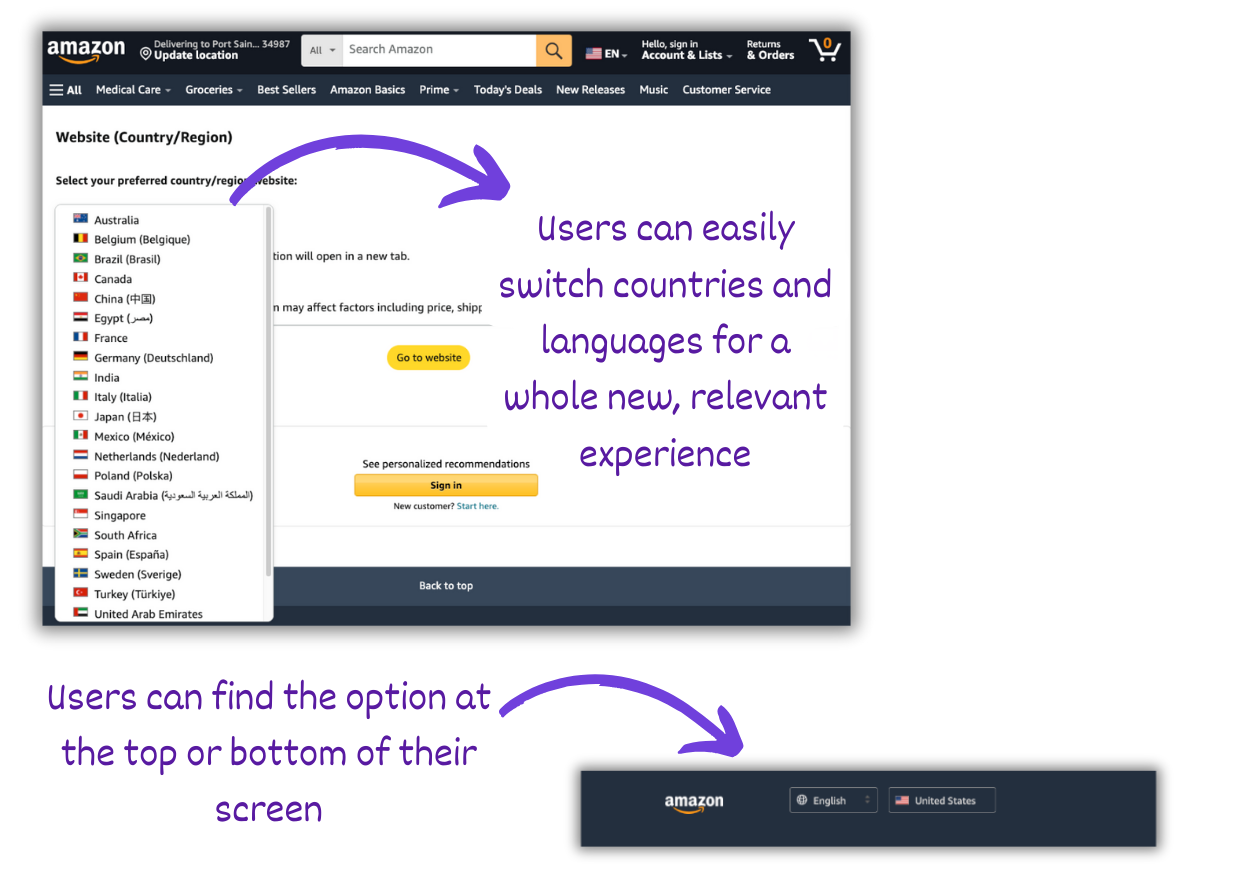 Amazon localized its global website for different countries and languages. This example shows how users can easily select their preferred language to customize their user experience. (Source: Amazon)
Amazon localized its global website for different countries and languages. This example shows how users can easily select their preferred language to customize their user experience. (Source: Amazon)
Why multilingual UX is so difficult
Thinking about all the variables involved in creating multilingual websites can make your stomach turn. If you want to grow, you have to translate your website into dozens of local languages, localize your site’s design elements and experiences, and continuously keep content up-to-date. That can add up to hundreds of thousands of tasks (or more) per year.
Plus, brands often face translation complexities, such as understanding and communicating cultural nuances. Design isn’t so straightforward, either. For example, languages like German might have longer words than English, so designers must consider how translated content fits on a desktop, smartphone, or tablet screen. And if all goes well, companies still need a system that can host and deploy these different website versions when needed.
The good news is that companies no longer have to rely on clunky design processes and high labor costs to make multilingual UX possible. Today, they can leverage AI-powered solutions that take some of the heavy-lifting off their teams’ plates and help them easily create curated multilingual user experiences that delight audiences and drive conversions. But first, companies need a brand voice that resonates across all target cultures.
The importance of one brand voice in multiple languages
Multilingual website design involves how the website looks and feels in addition to the words users read. If you’ve already globalized your user interface by adopting tools to localize and deploy your design and content, you can easily adapt your website and brand for different audiences.
Guy Leon, CEO of Betterweb.ai, a solution for web accessibility, stated in a Smartling interview that companies need to “maintain a consistent user interface across languages.” He explained how his company translated content for regional Spanish variants in Latin America while maintaining the same interface to create consistent user experiences.
Brand voice and experience are the most important part of your multilingual strategy. After all, if your brand comes across as different for each audience, then it’s essentially a different company in each market. Does your English brand message mean the same thing in Mandarin Chinese, Spanish, French, and Arabic? You can lose control of your brand perception and risk offering lower-quality experiences that don’t connect with local audiences if you use translations that don’t align with your brand. 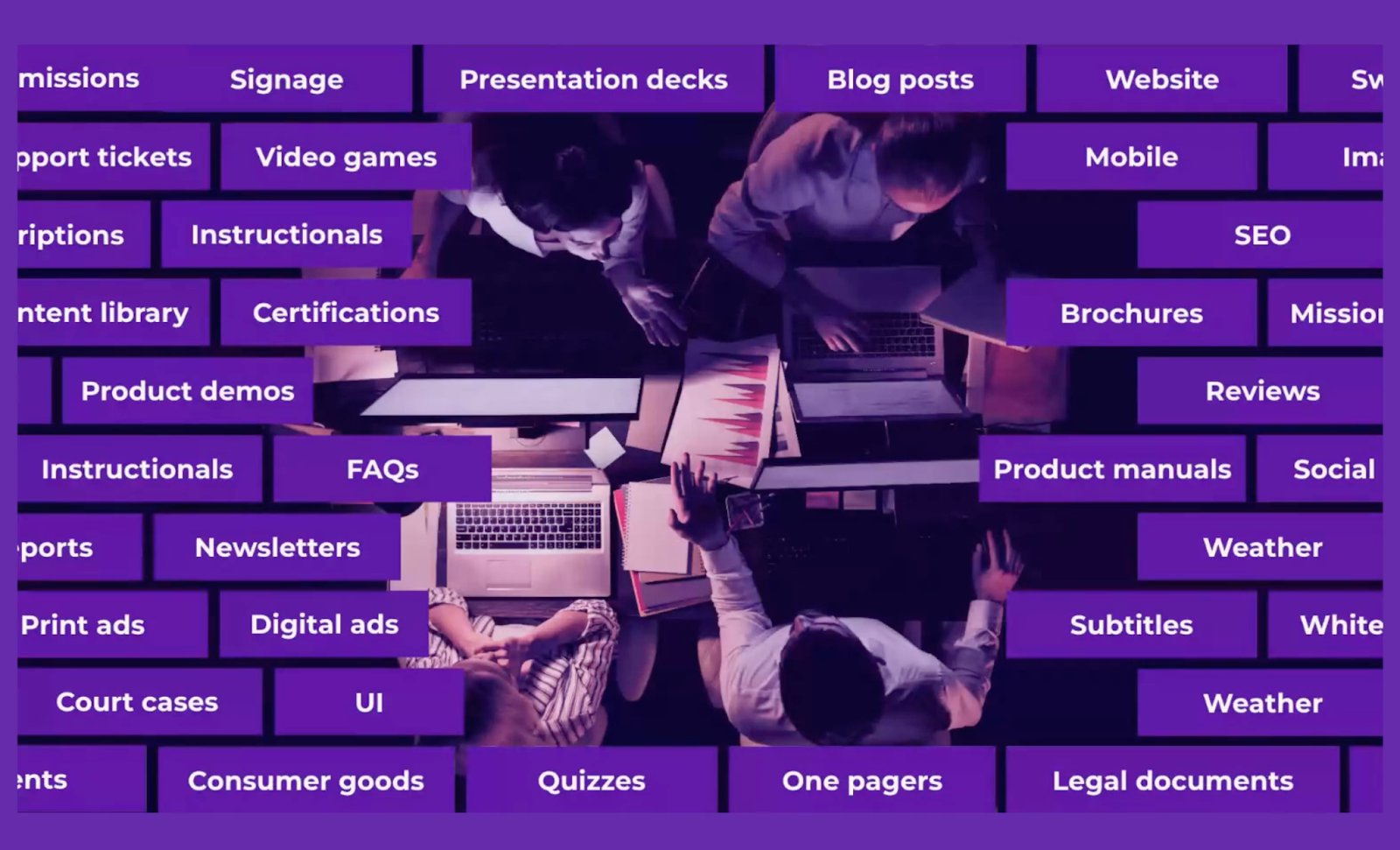 There are thousands of linguistic assets across an organization. That’s why it’s essential to ensure that the brand experience and voice are consistent across local audience experiences. (Source)
There are thousands of linguistic assets across an organization. That’s why it’s essential to ensure that the brand experience and voice are consistent across local audience experiences. (Source)
In Smartling’s free webinar, Mastering Linguistic Assets, Olga Beregovaya states that “there is nothing more valuable than a corpus that actually represents a brand voice.”
In the same webinar, Jason Rauchwerk shows an example of brand voice and experience based on the Spanish language. One translation experiment uses the formal “usted” address for “you.” To make it more personal for the brand voice, Rauchwerk wants to use the “tu” form for “you.” However, manually making those changes can be complex due to how long it would take to adjust subject-verb agreements.
“Our style guide specifies that we want to use the ‘tu,’ or the informal form of ‘you.’ […] The [machine] translation [‘usted’] isn’t totally wrong, but it lacks fluency,” Rauchwerk says. “With a [large language model], the sentence is totally natural.” 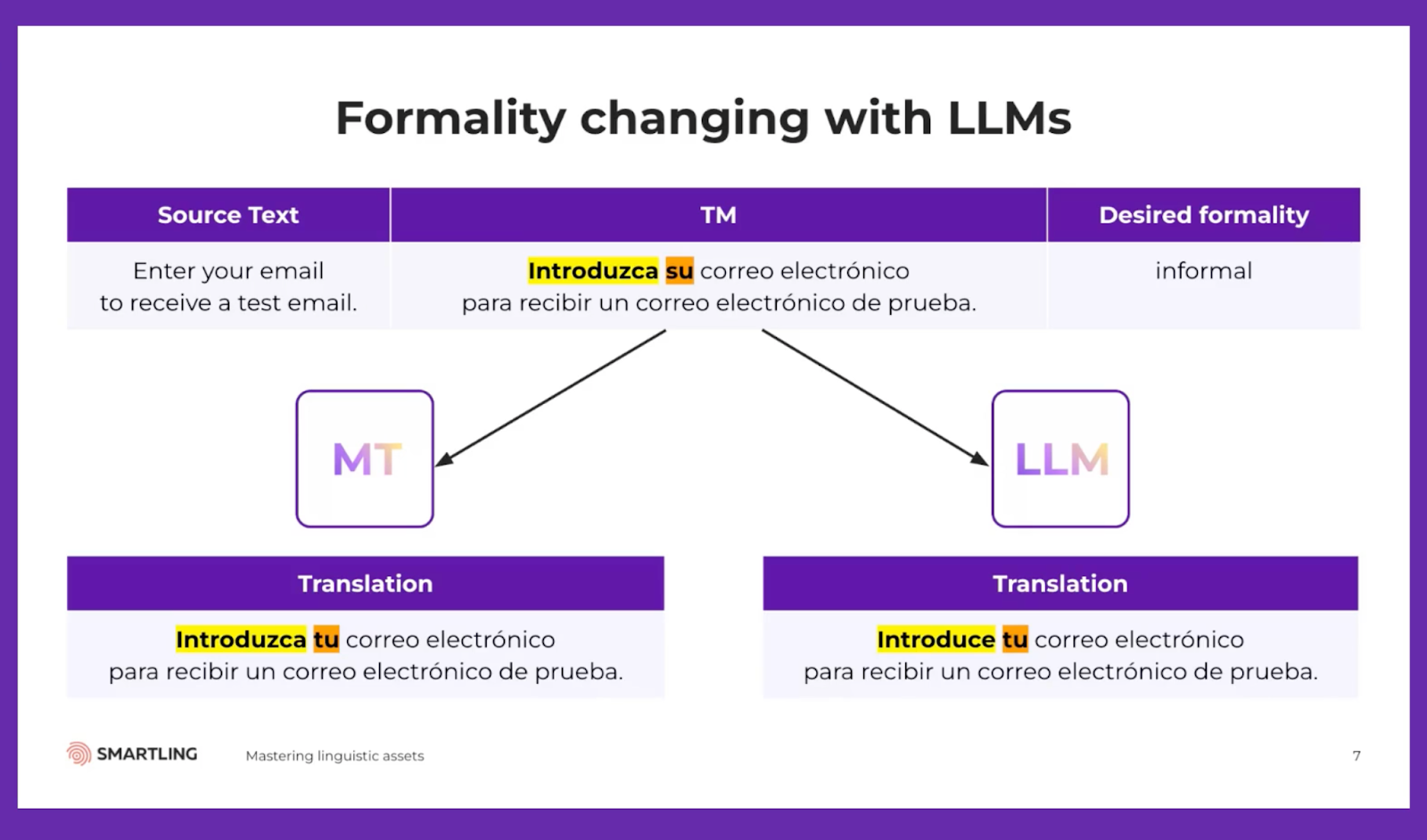 In this example, a company would need to change the word used for “you” in Spanish. (Source)
In this example, a company would need to change the word used for “you” in Spanish. (Source)
Using style guides and glossaries prevents brand misrepresentations and creates a powerful, consistent brand message for long-term growth.
How to implement a unified brand voice
These three critical areas can help you improve your multilingual brand voice:
1. Transcreation
Transcreation combines localizing text and creating new content to connect with a local audience and convey the intended meaning from the source language.
For example, McDonald’s transcreated its content by rewriting “I’m lovin’ it” for its Spanish-speaking audience. The literal translation, “amor,” would’ve been too strong a word to use for food, so McDonald’s slogan instead read “Me encanta,” which still conveyed the meaning of love without a romantic undertone.
2. Local expert linguists
Local translators not only speak your target language fluently but also have a native understanding of their own culture. These experts are qualified to determine whether your localized translation conveys the same message to your target audience as the original content.
Local experts can also help you localize your content so it not only means the same thing but also sounds like your brand. This way, you won’t have to manage dozens of versions of your company across different cultures.
3. Translation memory
As you grow your multilingual UX design strategy, it’s important to invest in the long term. Building your translation memory is key to setting your multilingual UX strategy up for success.
Linguists can create faster, more consistent machine translations by leveraging translation memory, which stores previously approved translations, phrases, and strings for future application, saving you money and time on translations.
In addition to translation memory, your translators can leverage Smartling’s CAT Tool, which provides visual context for translations and designs. You can make revisions based on word length, how content looks on the webpage, and language nuances like idioms and evolving vocabulary.
How to scale design and content workflows to include multilingual UX
As companies look for solutions to scale their multilingual websites for growth, they must adopt a tech stack that makes it easy for them to localize and manage content on a global scale.
Your brand can use AI technology, such as machine translation, to speed up the translation process and achieve cost-effective translations at high volumes. Smartling’s Neural Machine Translation Hub chooses the best translation engine for each language pairing and content type to provide highly accurate output. Then, our local expert linguists verify the content within our translation management system. They can also use the CAT Tool for visual context to improve and localize content.
5 multilingual UX best practices
So how do you get started with multilingual UX?
First, it’s critical to look at your website to ensure that it’s globalized and ready for a multilingual user experience. You can follow these best practices to jumpstart your localization plan:
1. Simplify your copy using local experts
Your English website should have clear, concise copy. The same goes for all of your localized versions, whether they’re in Japanese, Hebrew, or any other language. Your website’s design should also be modern but minimal so you can easily adapt it for different cultures.
That’s why it’s important to leverage expert local linguists. They can help you adjust copy through transcreation to connect with your audience’s culture and meet their multilingual design preferences.
2. Leverage visuals based on your target audience
Don’t sleep on visuals. You should adapt all graphics and symbols—as well as your entire UX—for each local audience.
For example, if you’ve localized your web page for your Chinese customers, they are more likely to connect and identify with your brand. Otherwise, your brand may come across as foreign, and your customers may feel as though your company doesn’t truly understand their needs and pain points.
The same point applies to attributes like colors. According to Elliott Kosmicki, founder of the marketing agency Major Impact, “different cultures perceive color, images, and messaging differently.” As an example of this, Kosmicki relays how his agency “invested heavily in research to understand cultural nuances before launching new sites. Our Spanish site used warmer colors and emotive language, reflecting cultural preferences, [while] our German site took a more formal tone.
“Consistency in UI and branding is key,” he adds. “Users expect familiar navigation and branding regardless of language. We kept [about] 70% of our US site consistent across languages. The remaining 30% was custom to match cultural expectations.”
These kinds of considerations can make a big difference for your multilingual UX.
3. Allow users to change or choose languages and locations
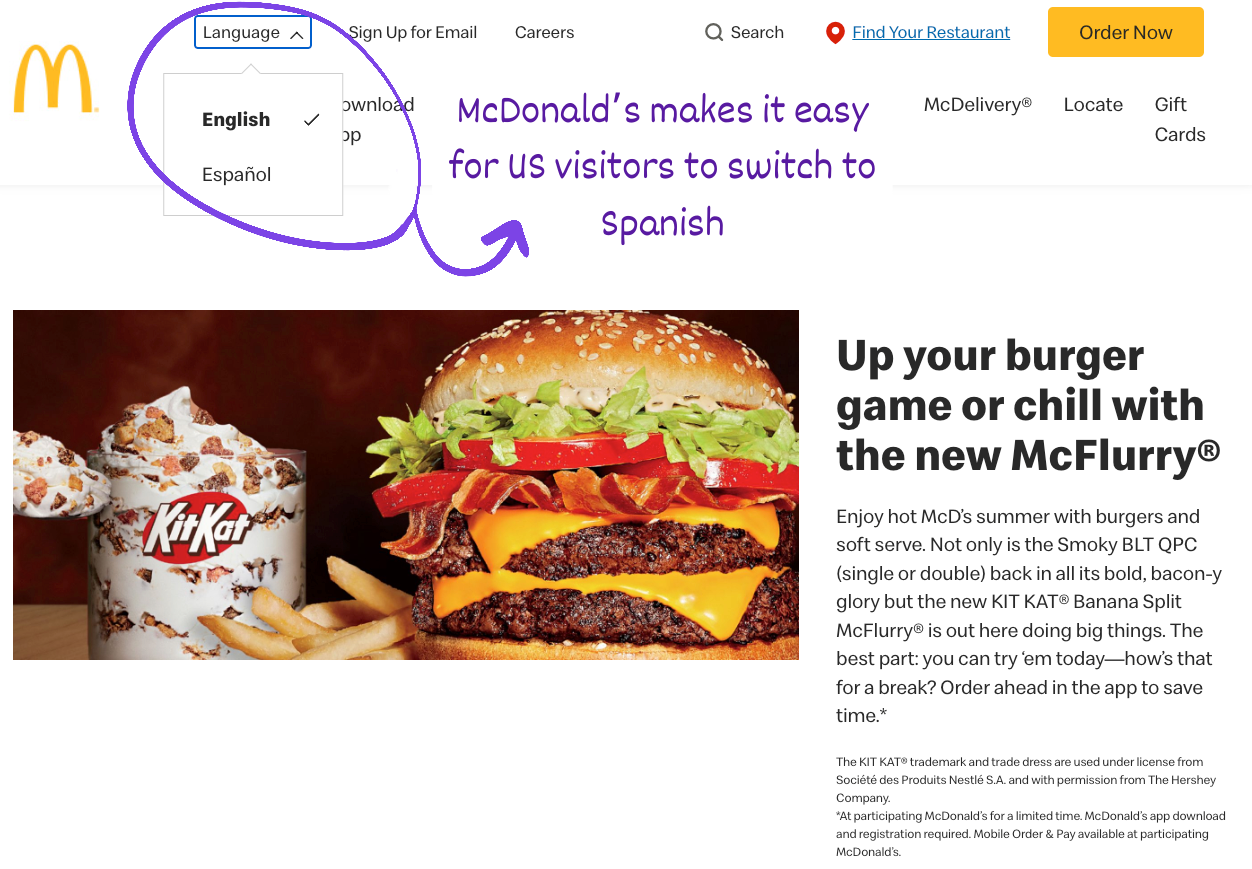 An example of multilingual UX options (Source: McDonald’s home page)
An example of multilingual UX options (Source: McDonald’s home page)
In the image above, McDonald’s provides an easily discoverable option for US visitors to switch to Spanish, the second most popular language in the country. When someone visits your website, language options shouldn’t be hard to find. Customers should be able to switch to their language in seconds.
Once you publish content, Smartling’s Global Delivery Network can deploy the right localized content to your website’s visitors. This way, content can flow seamlessly from your website into Smartling for translation.
By creating a UX that allows customers to find their language quickly, you can eliminate friction points that would otherwise drive visitors to leave your site. 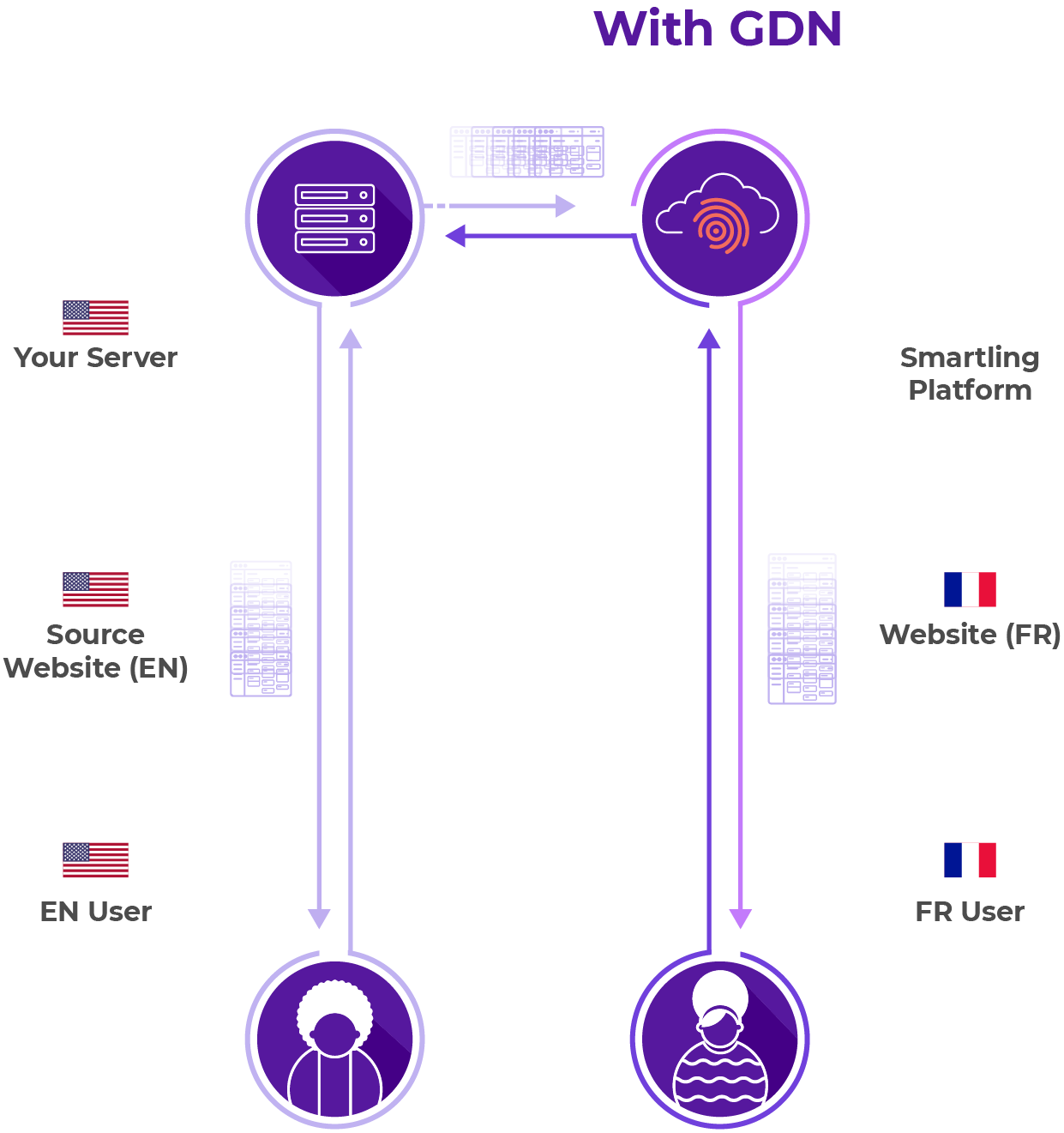 Smartling’s Global Delivery Network automatically deploys localized content based on location and website type. (Source)
Smartling’s Global Delivery Network automatically deploys localized content based on location and website type. (Source)
4. Test the experience and continuously improve
Your multilingual webpages might look great—but how do they communicate with users?
Brands can connect with their local audiences to see how their content resonates. This could save them time identifying areas for improvement and provide unique insight from real-life customers. One great way to vet pages before testing them on an audience is to use local linguists who can catch easily avoidable mistakes.
5. Implement high-quality localization solutions
While many of the previous steps involve preparation, you need a stack that can help you quickly localize and translate content and provide a real-time website experience for each target culture.
Your brand needs a solution that combines localization technology and human services to help you provide an end-to-end multilingual UX design for all audiences.
How Smartling handles multilingual UX
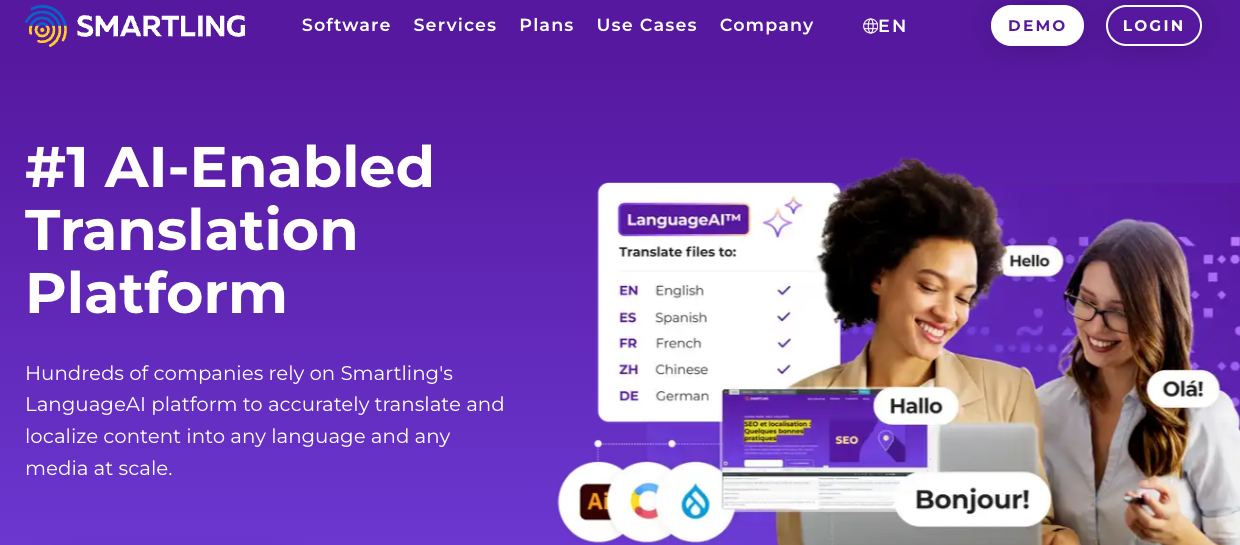 Smartling provides the technology and services you need to reach local audiences worldwide. (Source)
Smartling provides the technology and services you need to reach local audiences worldwide. (Source)
Smartling is the all-in-one solution you need to create a multilingual brand experience. With our translation technology, brands can have everything they need to translate, manage, and deploy multilingual experiences.
Our translation management system gives you a single touchpoint to manage every aspect of the multilingual UX process without cumbersome spreadsheets. That way, you can create localized website content that more effectively connects with your local audience.
You don’t have to do it alone, either. You can use our expert translation and management services to help you confidently market to new local audiences with high-quality content.
Book a meeting today to see how Smartling can help you create a multilingual UX design that drives sales.
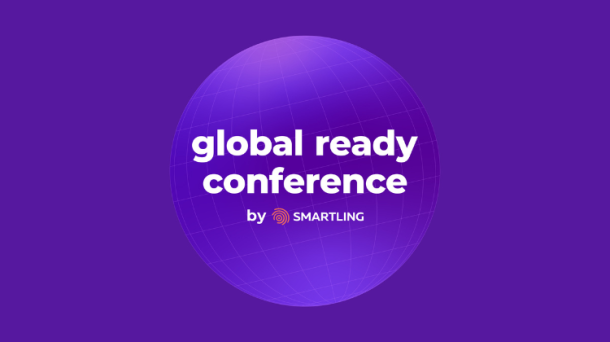
.jpg)





